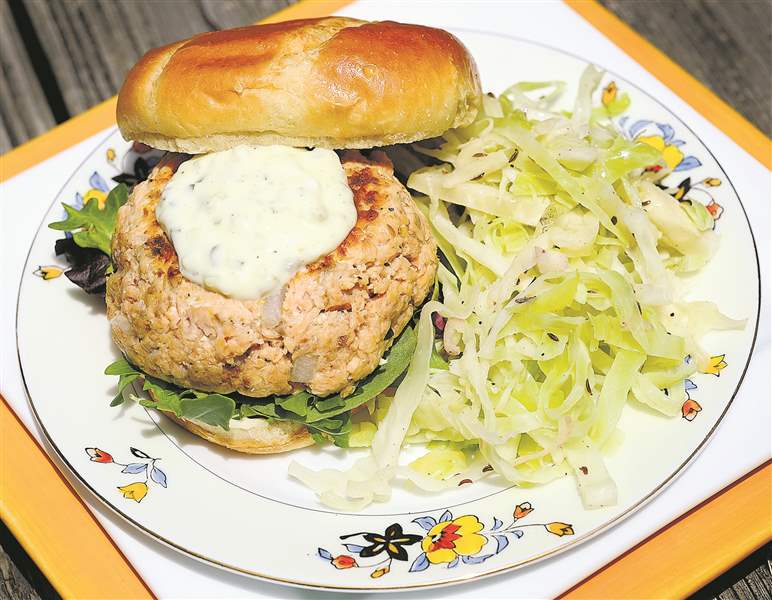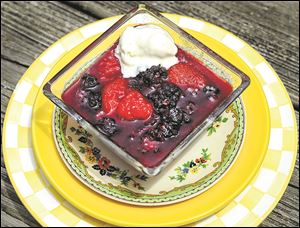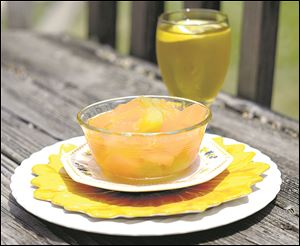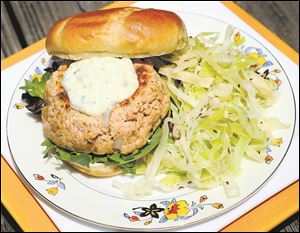
Northern delights: Summer foods from Arctic Circle
6/28/2016
All Alaska salmon burger.
THE BLADE/JEREMY WADSWORTH
Buy This Image
Summer has come to the Land of the Midnight Sun.

Rødgrød med fløde (Danish berry dessert with cream).
The Arctic countries — Canada, Denmark, the Faroe Islands, Finland, Greenland, Iceland, Norway, Sweden, Russia, and our own United States, thanks to Alaska — are often thought to be permafrosted tundra, even in the summertime. Admittedly, above the Arctic Circle, there is little vegetation.
But just a bit farther south, those northerners are basking in the glorious season we are. Wildflowers paint the landscape in rich colors. The boys of summer are playing in the Alaska Baseball League. Camping, hiking, picnicking, and other outdoor activities are practically mandatory.
Summertime foods are fresh and fantastic. Gardening, farmers’ markets, salmon runs, foraging, and berry picking are all being celebrated right now.
Sure, there are greenhouses for producing all sorts of beautiful plants and edibles year-round. But with temperatures that can reach into the 80s at times in some locations, and as many as 20 hours of sunshine each day during the summer months, why not take advantage of a growing season that’s short but intense?
Northern vegetables are famous for their enormous sizes. According to the Guinness Book of World Records, a 138.25-pound cabbage was shown at teh Alaska State Fair in Palmer in 2012. An Alaska-grown 35-pound broccoli and a cauliflower weighing more than 31 pounds have also had their moment in the sun.

Melon preserves.
In the Scandinavian countries, Midsummer is one of the most important holidays and takes place at the time of the solstice. Bright bonfires are lit throughout the region. Swedes dance around a maypole, and the traditional menu includes herring and new potatoes in a sauce of dill and sour cream.
In Norway, Sankthansaften (also known as Jonsok, or St. John’s Day) is a holiday in mid-June known for get-togethers and picnics. Open-faced sandwiches are often served, as is rømmegrøt, a porridge enriched with milk and sour cream that is reserved for special occasions.
With the warmer temperatures and brighter sunshine come lighter foods, rather than famously heavy dishes like Swedish meatballs, beef stroganoff, or perhaps a chili made with moose meat. And the dishes are easy to prepare, because who wants to be cooped up inside when summer is so brief and so alluring?
Warm weather dishes in the Arctic region, whether sweet or savory, celebrate the fleeting season and are beautiful in their simplicity. They allow the ingredients to shine as brightly as the summer sun.

All Alaska salmon burger.
All Alaska Salmon Burger
This recipe comes from a former member of the Alaska House of Representatives. It was contributed to a community cook book produced to support fund-raising for the Special Olympics when the games were hosted in Anchorage in 2001. Alaskan salmon run from May through October, but the prized kings are at their peak in July.
1 16.5-ounce salmon filet, cooked, flaked
1/2 cup chopped onion
1/2 cup fresh whole wheat bread crumbs
2 eggs
1 tablespoon lemon juice
1 tablespoon lemon zest
1/2 teaspoon rosemary, crushed
Kosher salt
Freshly ground black pepper
Oil
4 burger buns
Choice of toppings (mayonnaise, ketchup, tartar sauce, barbecue sauce, cheese, pickle, etc.)
In a large mixing bowl, combine salmon, onion, bread crumbs, eggs, lemon juice, lemon zest, and seasonings; mix well. Form into four patties, place onto a plate, cover with plastic wrap, and let rest in the refrigerator for 30 minutes.
Heat oil in a large skillet and cook burgers over medium heat for 5 minutes per side until lightly browned. Serve with toppings of choice.
Yield: 4 servings.
Source: Adapted from Bill Hudson, The 2001 Special Olympics World Winter Games Alaska Cook Book.
Vitkålssallad/Pizzasallad (Cabbage Salad)
Salads of grated raw vegetables are very popular in Sweden. “These sorts of salad are called råkost, meaning ‘raw food,’” writes Magnus Nilsson of the restaurant Fäviken, who has been featured in season one of Netflix’s Chef’s Table. “A simple salad of shredded cabbage, tossed in vinaigrette, sometimes served with pickled bell peppers, is always found in Swedish pizzerias,” though the origin of this food pairing is unknown.
Vinaigrette:
3 tablespoons white wine or cider vinegar
6 tablespoons oil
Dijon mustard, to taste (optional)
Salt and white or black pepper, to taste
Salad:
1 small cabbage
1 shallot, finely sliced
1 tablespoon caraway seeds, lightly toasted
Salt and black pepper, to taste
Make the vinaigrette: Whisk all the ingredients together in a bowl. If you are using mustard, it will emulsify and thicken it a little bit.
Make the salad: Use a mandoline to slice the cabbage thinly. Dress the shredded cabbage, shallot, and caraway seeds with the vinaigrette, and leave the salad to sit for at least an hour. Add salt and pepper to taste.
Yield: 6 to 8 servings.
Source: Adapted from Magnus Nilsson, The Nordic Cook Book.
Rødgrød Med Fløde (Danish Berry Dessert with Cream)
This is considered to be “truly a national dish,” writes Claus Meyer, co-founder of Noma, which was named No. 5 among San Pellegrino’s World’s 50 Best Restaurants 2016. “A perfectly cooked, smooth compote with a mixture of mild and intensely flavored berries served with ice-cold milk and crunchy sugar is royal dining indeed.”
3 1/2 cups fresh mixed berries, such as strawberries, currants, blueberries, and blackberries
2/3 cup fresh raspberries and/or blackberries
1/2 cup water
3/4 cup sugar, plus extra for sprinkling
1 tablespoon potato starch or cornstarch mixed with 2 tablespoons cold water
Rinse the berries in cold water and then remove the stems and hulls. Put all the berries except the 2/3 cup raspberries and/or blackberries in a pan with the 1/2 cup water and sugar. Stir well, and let steep for 2 hours so that they give off some of their juices.
Place the pan over medium-high heat. When warm, but before the berries reach the boiling point, thicken the compote by stirring in the potato starch paste. Bring just to the boiling point, then turn heat to medium-low; continue to cook for 3 minutes. Remove the pan from the heat, skim off foam, and gently stir in the remaining fruits so that they remain as whole as possible.
Pour the compote into a serving bowl. Sprinkle the compote with a thin layer of sugar to prevent a skin from forming and let cool in the refrigerator. Serve the berry compote with milk, cream, or a scoop of good vanilla ice cream.
Yield: 6 servings.
Source: Adapted from Claus Meyer, The Nordic Kitchen.
Melon Preserves
“Russians are most likely to enjoy these lovely preserves in a small dish with tea,” writes Darra Goldstein, a professor of Russian at Williams College in Williamstown, Mass., and founding editor of the journal Gastronomica. “[But] I like them best American style, poured over vanilla ice cream.”
1 3-pound honeydew melon and/or cantaloupe, slightly underripe
1 tablespoon freshly squeezed lemon juice
4 1/2 cups water
1/3 cup vodka
1/2 cup mild honey
1 cup sugar
1-inch piece of fresh ginger root, peeled
1 vanilla bean
Remove the rind from the melon and cut the flesh into 1 inch cubes. You should have about 4 cups.
Bring 3 cups of the water to a boil in a large saucepan along with the lemon juice. Add the melon cubes, then return the water to a boil. As soon as the water boils, drain the melon, refreshing it with cold water to stop the cooking. Drain well.
Place the melon cubes on a baking sheet and sprinkle with the vodka. Let stand for 15 minutes, spooning the vodka over the melon a couple of times.
Meanwhile, place the remaining 1 1/2 cups water in a saucepan with the honey, sugar, ginger root, and vanilla bean. Bring to a boil and boil for 3 minutes, then add the melon and vodka. Simmer until the melon is translucent, about 10 minutes. Remove from the heat and cool to room temperature, then remove the ginger root and vanilla bean.
Pack the preserves into a quart jar. Either seal for long storage or keep refrigerated.
Yield: 1 quart.
Source: Adapted from Darra Goldstein, A Taste of Russia.
Contact Mary Bilyeu at mbilyeu@theblade.com or 419-724-6155 or on Twitter @foodfloozie.